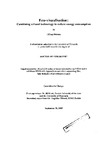Eco-visualisation: Combining art and technology to reduce energy consumption
| dc.contributor.author | Holmes, Tiffany | |
| dc.contributor.other | Faculty of Science and Engineering | en_US |
| dc.date.accessioned | 2013-11-20T14:22:02Z | |
| dc.date.available | 2013-11-20T14:22:02Z | |
| dc.date.issued | 2009 | |
| dc.identifier | NOT AVAILABLE | en_US |
| dc.identifier.uri | http://hdl.handle.net/10026.1/2784 | |
| dc.description.abstract |
Artworks that display the real time usage of key resources such as electricity offer new strategies to conserve energy. These eco-visualisations-or artworks that creatively visualise ecologically significant data in real time-represent a substantial contribution to new knowledge about dynamic feedback as a tool to promote energy conservation and environmental site-based learning in this interdisciplinary project that expands and builds on prior findings from the fields of art, design, environmental psychology, and human computer interaction (HCI). The aims of this research endeavor were to locate answers to the following questions related to energy conservation in various public contexts. Might dynamic feedback from data-driven artwork create a better understanding of resource consumption patterns? Which environments are best for promoting eco-visualisation: borne, workplace, or alternative spaces? What kinds of visualisation tactics are most effective in communicating energy consumption data? These initial questions generated a four-year research project that involved an extensive literature review in both environmental psychology and art history that culminated in three different case studies, which targeted the effectiveness of eco-visualisation as an innovative conservation strategy. The three primary claims to be proven with supporting evidence from the literature reviews and case studies are: (1) eco-visualisation offers novel visual ways of making invisible energy data comprehensible, and encourages site-based learning; (2) eco-visualisation that provides real time visual feedback can increase environmental awareness and possibly increase the conservation behaviour in the viewing population; (3) eco-visualisation encourages new perceptions of linkages between the single individual and a larger community via site-based dialogue and conversation. Although the results of the three case studies are generally positive and prove the claims, there are larger social and environmental questions that will be addressed. How can eco-visualisation be productively integrated into the home or workplace without becoming a disposable gadget that represents a passing fad or fancy? Most importantly, how can energy conservation interventions be conceived to be as sustainable as possible, and non-threatening from a privacy perspective? These questions and more contribute to the discussion and analysis of the results of the three case studies that constitute the primary source of new knowledge asserted here in this dissertation. | en_US |
| dc.language.iso | en | en_US |
| dc.publisher | University of Plymouth | en_US |
| dc.title | Eco-visualisation: Combining art and technology to reduce energy consumption | en_US |
| dc.type | Thesis | |
| plymouth.version | Full version | en_US |
| dc.identifier.doi | http://dx.doi.org/10.24382/3728 |
Files in this item
This item appears in the following Collection(s)
-
01 Research Theses Main Collection
Research Theses Main


